The Wrack
The Wrack is the Wells Reserve blog, our collective logbook on the web.
The Wrack is the Wells Reserve blog, our collective logbook on the web.
On a classic October morning, a research team heads to the Eliot–South Berwick line, where a private landowner has opened his property for a Wells Reserve study of fish and fish habitat. Parking the pickup at the end of a long hayfield, the five gather up gear and step into a middle-aged pine-oak forest, then head downslope past ferns and toppled trees till the trail goes wet underfoot, the canopy breaks, and they stand at the edge of Shoreys Brook. This is headquarters for the next few hours. It is one of eight sites along the brook’s 4.3 miles being surveyed for resident and migratory fish, and their habitat, in advance of a planned dam removal downstream.
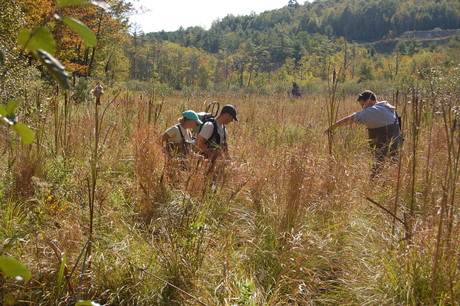 Near its source, Shoreys Brook is narrow enough to step across. Banks of thick grass and small shrubs rise to woodlands north and south, while to the east a secluded patch of marsh grass is rich with the yellows and reds of early autumn.
Near its source, Shoreys Brook is narrow enough to step across. Banks of thick grass and small shrubs rise to woodlands north and south, while to the east a secluded patch of marsh grass is rich with the yellows and reds of early autumn.
The research crew is lucky today. It’s a beautiful morning with bright sun, a light breeze, cool air, and no flies or mosquitoes to speak of. Spring and summer were often a different story, so a collective appreciation floats in the air.
Everyone pulls on chest waders and sorts through their equipment and supplies. Emily Thornton, who will collect the habitat data, grabs a tape measure and wire flags to mark the brook segment to be studied. Kate Reichert joins her, working through the prickers to measure 200 feet upstream and downstream while setting markers at specific intervals along the way.
When Emily and Kate finish marking, they settle into habitat work while the fish team gets started. Fishing’s a three-person job: shocker, netter, and bucket carrier.
Jacob Aman is today’s shocker. Jake hoists an electrofishing generator onto his back, tosses a 10-foot wire braid into the water, and wields a white pole with a halo at the bottom end. When he presses a switch on the wand, a high-pitched beeping warns that a current is flowing between the halo and the braid, electrifying the water just enough to stun small aquatic animals.
The netter, Jeremy Miller, stands by with a long-handled dip net suspended in the water just downstream of Jake. The electric current will affect fish only briefly, so he will need to act fast or the target will escape.
Timothy Dubay stands by with a bucket half filled with brook water. That will be the temporary hold for any fish caught today.
The electrofisher’s reach is only a few feet, so the team works its way upstream just a few steps at a time. At each stop, everyone gets into position and focuses full attention on the water. Jake switches the current on and glides the halo below the surface. Each attempt lasts a few seconds and most are uneventful.
When someone blurts “There’s an eel!” Jeremy proficiently scoops a narcoleptic Anguilla into the net and hastily moves the pencil-thin fish to Tim’s bucket. Already the eel is recovering, but it is trapped in the hold for now.
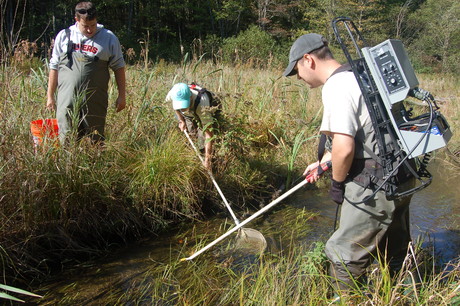 So it goes: Steady, methodical progress upstream interrupted by momentary bursts of activity. A couple more eels go into the bucket and an occasional frog or salamander is caught and released (“If it has legs it’s not a fish,” Jeremy quips). Now and then a gangly water scorpion finds its way into the net, giving some crew members the willies. One burly guy shivers at the sight of a giant water bug that looks as big as a rubber coin purse.
So it goes: Steady, methodical progress upstream interrupted by momentary bursts of activity. A couple more eels go into the bucket and an occasional frog or salamander is caught and released (“If it has legs it’s not a fish,” Jeremy quips). Now and then a gangly water scorpion finds its way into the net, giving some crew members the willies. One burly guy shivers at the sight of a giant water bug that looks as big as a rubber coin purse.
Today’s a training session, too, so Jeremy hands the net to Tim for a spell. Catching eels isn’t as easy as the experienced hand had made it look. On his first try, Tim’s too slow. On his second, the net jams against a submerged stick and an eel escapes. Next time, though, Tim slides the net under the eel and lifts it out of the water. It’s a little one, just a few inches long, and Jake’s urgent “Get your hand under it!” comes just as the eel slides through the net’s weave and plops lightly back into the brook.
Tim doesn’t let discouragement show and he gets solid support from Jake. “Don’t worry about it. It’s not easy. We’ve all lost fish. Slippery as an eel is not just a saying.” (Get your hand over it is the imperative if eels are a bit bigger, because they’ll slither right over the edge of the net if given half a chance.)
Before the fishing team finishes, Kate steps in to test her aim and reaction time with the net while Tim goes back downstream to wrap up the habitat work with Emily.
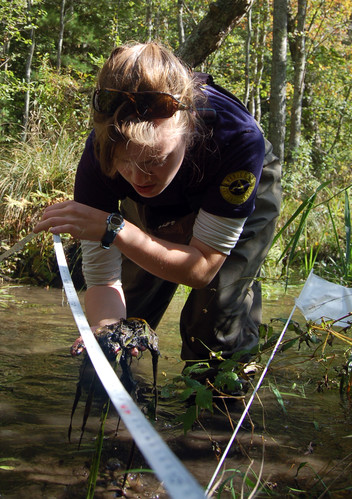 Describing Habitat
Describing HabitatIf fishing was a painstaking process, characterizing habitat is more so. Emily evaluates a daunting set of habitat details at stop after stop, reporting her metrics and judgments to her streamside scribe.
Maintaining balance on an uncertain bottom, she measures the width of the brook, its depth, and the length of each riffle, run, and pool. She labels streambank condition, classifies pool types, and plunges a bare hand into the muck at the bottom, pulling up a gob of substrate to ascertain its texture — “No sand in there... it’s all fines,” she reports.
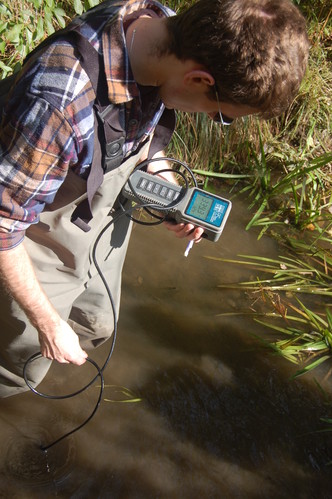 Her assistants, first Kate and now Tim, use handheld probes to take the brook’s temperature and test its salinity, dissolved oxygen, conductivity, and pH. Their double-sided data sheets fill with numbers, wrinkle with water droplets, and now and then host a resting dragonfly.
Her assistants, first Kate and now Tim, use handheld probes to take the brook’s temperature and test its salinity, dissolved oxygen, conductivity, and pH. Their double-sided data sheets fill with numbers, wrinkle with water droplets, and now and then host a resting dragonfly.
The work appears to be a blend of tedium and fascination, monotony and discovery. It is the beauty of nature inspected up close and the pain of a wild rose reaching out to snag an unsuspecting forearm. The pair achieves a practiced rhythm as the hours pass, the transect lengthening behind them. After wrapping up at one pool, Emily squints ahead to the next and announces, “I see the flag. The end is in sight.”
A day earlier and a couple of miles downstream, Tin Smith described the reason behind this fish monitoring to a dozen people gathered at the Raymond and Simone Savage Wildlife Preserve during a Coastal Training Program workshop.
“This dam has likely been in place in some form or other since the middle of the 17th century,” Tin explained. “It was probably constructed for milling lumber and grain.”
Over the years, the dam was broadened and bolstered as needed. The old mill pond was a popular swimming hole during the first part of the 20th century, then the property became a private residence for six decades. In 2008, the 27-acre site was bequeathed to Great Works Regional Land Trust by its owner, Simone Savage. It was not long before the land trust began to eye the dam with thoughts of removing it to restore habitat.
The dam had partially breached in 1998 and the water level behind it had dropped enough to cause erosion at an upstream culvert under Route 101. To stabilize the busy highway, the Maine Department of Transportation has decided to install a new strut and culvert, a task that complements the dam removal project beautifully.
Using Shoreys Brook as an example, Tin encouraged his group, saying “Big projects can be done by small organizations.” In this case, an enormous advantage came from the fact that the dam and adjacent land were held by a single landowner, Great Works Regional Land Trust. Tin said he and many others involved with the restoration project were “amazed that it has happened so quickly,” a testament to the foresight and collaboration of project partners and their key supporters.
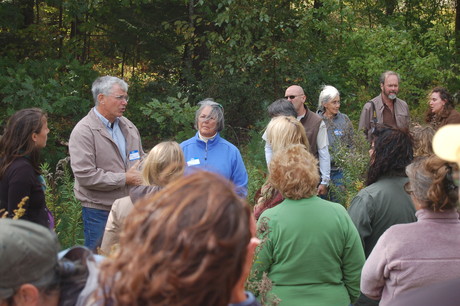
For some 350 years, eight species of migratory fish that once moved with ease into Piscataqua River tributaries — sea lamprey, rainbow smelt, blueback herring, alewife, American eel, American shad, sea-run brook trout, and Atlantic salmon— have been discouraged or prevented from reaching miles of potential spawning habitat along Shoreys Brook. This year’s pre-restoration fish surveys have indicated that tenacious eels, famous for their ability to surmount obstacles, can pass in some number upstream, but alewives and other migratory fish are clearly blocked by the dam.
Removing the 170-foot earth-and-concrete dam and repairing the perched culvert under Route 101 are expected to restore migratory fish, improve water quality, and ensure sediments are supplied downstream. A small amount of stream bed reconstruction is planned, but mainly the brook will be allowed to find its own course. The restoration focus instead will be on creating a gentle slope alongside the brook so a flood plain and salt marsh can be encouraged to form. The head of tide is expected to move a couple of hundred feet upstream, as well. In the end, the tidal portion of Shoreys Brook is meant to resemble what it looked like prior to European settlement.
Having established a 2011 baseline, the Wells Reserve science team intends, funds permitting, to return for followup fish surveys in years to come. Their deep-seated hope is to find river herring, smelt, and other long-lost species living and reproducing again in the quiet backwaters of Shoreys Brook.
From Watermark 28(2): Fall 2011
Donations to Laudholm Trust make Wells Reserve research possible. Please consider making a gift to support science in our communities.